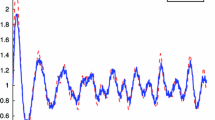Abstract
We show that a system of many linear inequality constraints will have a high proportion of redundant constraints with high probability. Implications for expected time of algorithms are indicated.
Similar content being viewed by others
References
J. Bentley, H. Kung, M. Schkolnick and C. Thompson, “On the average number of maxima in a set of vectors“,Journal of the Association for Computing Machinery 25 (1978) 536–543.
C. Blair, “Random linear programs with many variables and few constraints”, to appear inMathematical Programming.
B. O'Neill, “The number of outcomes of the Pareto-optimal set of discrete bargaining games“,Mathematics of Operations Research 6 (1981) 571–578.
S. Smale, “On the average number of steps of the simplex method of linear programming“,Mathematical Programming 27 (1983) 241–262.
S. Smale, “The problem of the average speed of the simplex method“, in: A. Bachem, M. Grötschel and B. Korte, eds.,Mathematical Programming: The state of the art (Springer-Verlag, Berlin, 1983) pp. 530–539.
Y.H. Wan, “On the average speed of Lemke's algorithm for quadratic programs“,Mathematical Programming 35 (1986) 236–246.
Author information
Authors and Affiliations
Rights and permissions
About this article
Cite this article
Blair, C. Random inequality constraint systems with few variables. Mathematical Programming 35, 135–139 (1986). https://doi.org/10.1007/BF01580644
Received:
Revised:
Issue Date:
DOI: https://doi.org/10.1007/BF01580644




